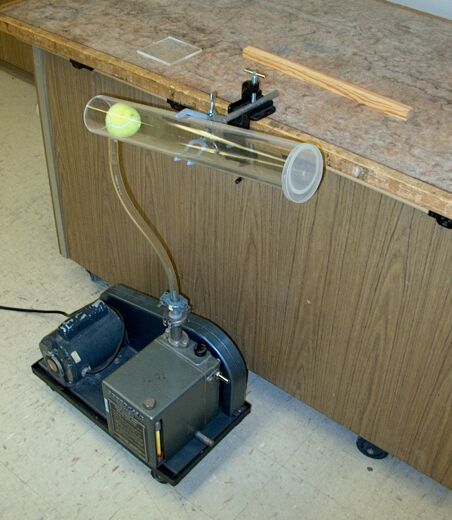

The clear plastic tube has both ends open and a small copper tube inserted through the side for connection to a vacuum pump. Use the wood rod to push the tennis ball into the front of the plastic tube until it rests on the copper tube. Place the plastic lid over the front opening. While holding the square plastic sheet over the rear opening, turn on the vacuum pump. Air pressure will hold the square sheet in place. Wait a few seconds, then, with the wood rod, knock the square plastic sheet off of the rear opening. The tennis ball will shoot out the front opening. As soon as you have fired the cannon, turn the vacuum pump off! You must minimize the time for which it pumps while it is open to the atmosphere.
When you prepare the air cannon as described above, there is enough leakage between the tennis ball and the wall of the plastic tube that the vacuum pump can actually evacuate the entire tube with the ball in place. If you place the ball in the muzzle and leave it uncovered, atmosphere might push the ball to the copper tube, but certainly not if you cover the end. It is easier just to push the ball all the way in, cover both ends and evacuate the tube. It is important that you let the class know that the pump is evacuating the entire tube.
The i.d. of the plastic tube is about 6.4 cm, which gives it a cross-section of about 32 cm2. The pressure that the atmosphere exerts over that area yields a force of 101,325 N/m2 × 32 cm2 × (1 m2/104cm2) = 324 N. So when you suddenly knock the plastic sheet off the back end of the tube, the tennis ball suffers a force of 324 N from the back end, with virtually nothing from the front. This force acts on the ball until it knocks the cover off the front of the tube.
Neglecting friction, we find that the ball is accelerated over a distance of about 39 cm (from rest in front of the copper tube until it knocks off the front cover when it is one radius from the opening), and calculate the work on the ball as 324 N × 0.388 m = 126 N-m. The mass of the ball is 56 g, and if we assume that all this work goes into kinetic energy of the ball, we calculate a muzzle velocity of √(2(126 kg-m2)/(0.056 kg-s2)) = 67 m/s, which equals 240 kph (150 mph)!
It turns out that the friction is on the order of about 15 N. (Measured first by pushing the ball down the tube with a tared stick on an electronic balance, then with masses, piling them on until, after the initial breaking of static friction, they kept the ball moving down the tube.) Even if we assume that it is 20 N, this changes the initial force of 324 N by only six percent, lowering the calculated muzzle velocity to 65 m/s, or 230 kph (140 mph). In either case, we expect drag to slow the ball slightly as it travels to the wall.
If the cannon is aimed at the exit sign and well evacuated, the tennis ball will actually hit the sign. Assuming that the ball has fallen half the sign height, or about 0.10 m, this means that it has taken about 0.14 seconds to travel the distance from the muzzle opening to the wall. The cannon sits roughly 7.75 m from the wall, at an angle of about 14 degrees. (The cannon opening is about 1 meter above the floor, and the top of the sign is about 3.1 meters above the floor.) So we have (7.75 m/0.14 s)/cos(14°) = 57 m/s, or 205 kph (127 mph). Given that we cannot be sure exactly how far the ball falls (it may be less than half the sign height), and that we have neglected drag, these numbers are reasonably close.
In any case, we can be sure that the ball is going quite fast when it exits the cannon! This is a dramatic demonstration, and it is good for waking up the class.